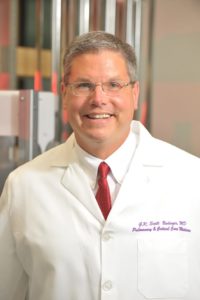
An age-related accumulation of a signaling molecule may be one culprit behind older adults’ vulnerability to viral pneumonias, according to a Northwestern Medicine study published in the Journal of Clinical Investigation.
The molecule, called hyaluronan, caused macrophages in the lung to become “older,” decreasing the immune cells’ proliferation in response to infection. Lowering levels of hyaluronan could reverse this phenomenon and merits more study, according to Scott Budinger, MD, the Ernest S. Bazley Professor of Airway Diseases, chief of Pulmonary and Critical Care in the Department of Medicine and co-senior author of the study.
“If you want to make an older macrophage young again, you’re not going to do it by just targeting the macrophage,” said Budinger, who is also a professor of Cell and Developmental Biology. “You’re going to have to actually target the fundamental processes that are making the lung old.”
Macrophages are among the first lines of defense against viral infections in the lung, including influenza and SARS-CoV-2, the virus that causes COVID-19. These cells cling to the walls of the lung, sampling the air and attacking foreign substances or recruiting other immune cells to the site.
Macrophages are self-replenishing, but as organisms age, their macrophages lose this regenerative ability, resulting in fewer immune cells overall and a diminished capacity to fight infections. Previous studies have shown that older mice have fewer macrophages, but the precise reason for this age-related decrease in macrophages remained unknown.
One theory involved a change in where the macrophages originated, but Budinger and his colleagues found that regardless of whether the macrophages originated from the bone marrow or not, they all suffered the same aging process that limited their effectiveness. Likewise, inserting “young” macrophages to an older lung caused those cells to lose effectiveness, whereas transferring “old” macrophages to a younger lung revitalized them.
“It’s all about the environment,” Budinger said. “It’s the old lung that makes the macrophages dysfunctional.”
Analyzing the thin layer of fluid on the surface of lung tissue in which the macrophages reside, the investigators detected a remarkable increase in hyaluronan, a signaling molecule whose precise function is still unknown. When large amounts of hyaluronan were applied to macrophages in test environments, it inhibited proliferation.
“I think it’s safe to say that this is probably one mechanism that makes old people more susceptible to viral pneumonias, including COVID-19,” Budinger said.
These findings align with results from recent clinical trials that showed benefits to lowering hyaluronan or increasing macrophage proliferation in older animals with viral lung infections, Budinger said, and he plans to conduct future experiments to learn more about this mechanism and how it might be exploited for therapeutic purposes.
Alexander Misharin, MD, PhD, assistant professor of Medicine in the Division of Pulmonary and Critical Care, was co-senior author of the study.
Co-authors of the study include Cara Gottardi, PhD, associate professor of Medicine in the Division of Pulmonary and Critical Care and director of the Walter S. and Lucienne Driskill Graduate Program in Life Sciences (DGP); Karen Ridge, PhD, professor of Medicine in the Division of Pulmonary and Critical Care and of Cell and Developmental Biology; Navdeep Chandel, PhD, the David W. Cugell, MD, Professor of Medicine in the Division of Pulmonary and Critical Care and a professor of Biochemistry and Molecular Genetics; Jacob Sznajder, MD, the Ernest S. Bazley Professor of Asthma and Related Disorders, professor of Medicine in the Division of Pulmonary and Critical Care and of Cell and Molecular Biology; and Benjamin Singer, ’07 MD, ’10 GME, assistant professor of Medicine in the Division of Pulmonary and Critical Care and of Biochemistry and Molecular Genetics.
Budinger, Gottardi, Chandel and Misharin are members of the Robert H. Lurie Comprehensive Cancer Center of Northwestern University.
This study was supported by National Institutes of Health grants U19AI135964, P01AG049665, R01HL147575, P01HL071643 and R01HL154686, and Department of Veterans Affairs grant I01CX001777.






